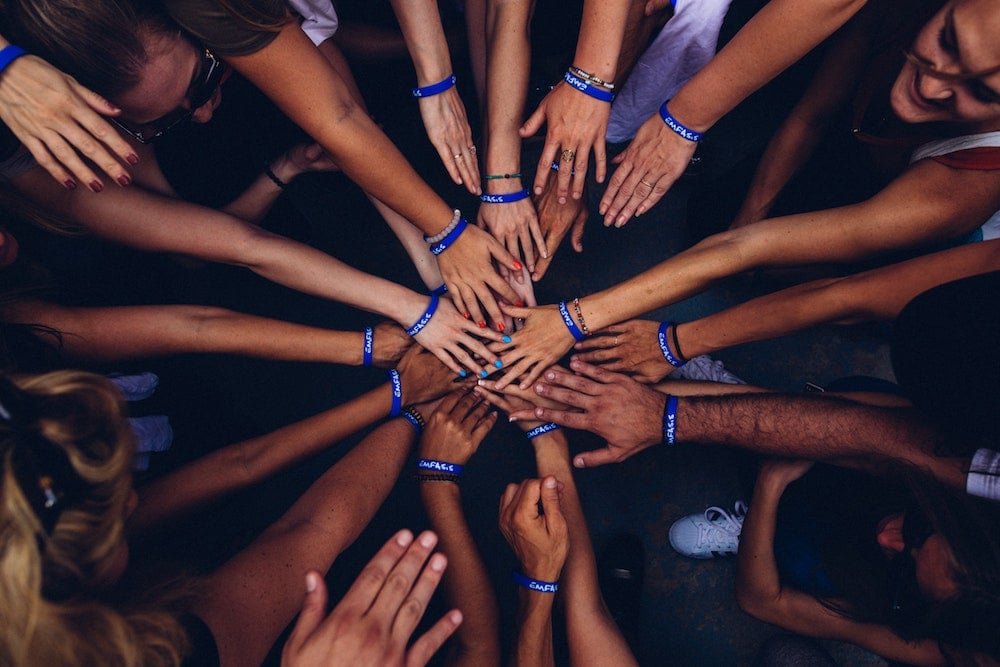
[Image above] We’re all in this together. Credit: Perry Grone, Unsplash
The coronavirus pandemic is impacting most aspects of life, one way or another—from the restaurant industry and cities that rely on tourism to orange juice, weather forecasts, brand logos, hair dye, and mining operations.
In a relatively short span of time, scientists around the globe have already learned a lot about how the virus works. For instance, while transmission of the SARS-CoV-2 virus is more likely to happen via aerosol droplets, the virus also can hang out on the surfaces of materials for up to three days and still potentially get someone sick (numbers of virus are low, but they are still there).
The virus persists reasonably well on plastic and stainless steel surfaces, that study shows, albeit less so on cardboard or copper, a material that’s antimicrobial, antifungal, and antiviral. According to the study’s authors, “Our results indicate that aerosol and fomite transmission of SARS-CoV-2 is plausible, since the virus can remain viable and infectious in aerosols for hours and on surfaces up to days (depending on the inoculum shed).”
And because the surfaces of materials are also a potential vector to transmit the virus, even cleaning companies are being affected by the pandemic, with increased demand in deep cleaning such as electrostatic sprayers to disinfect surfaces via oxidization.
Despite what we’ve learned about the virus, however, there are still many unknowns about SARS-CoV-2 and the disease it causes, COVID-19, which make if difficult to adequately respond scientifically and medically to the pandemic. Further complicating the situation is the fact that the outbreak’s widespread nature is having drastic effects on supply chains, depleting medical supplies and leading to life-threatening shortages.
Now, more than ever, it is critical for scientists, engineers, manufacturers, and other experts to contribute their knowledge, skills, and time to help advance our understanding of the virus and disease as well as devise strategies to mitigate the pandemic’s effects.
For instance, manufacturers large and small are pitching in to help address critical healthcare needs. For example, vacuum manufacturer Dyson is pivoting its normal factory operations to produce in-house designed ventilators, while footwear manufacturer Chaco is retrofitting one of its factories to manufacture face masks. Many other manufacturers are similarly switching gears to contribute to supply chains most in need during the pandemic.
Even small-scale or individual manufacturers can contribute via various additive manufacturing efforts, such as Nanohack–The Open Respirator Mask, where you can collaborate to design an open-source 3D-printed face mask made with antimicrobial materials.
In addition to manufacturing-based efforts, there is also great need for help with data-gathering initiatives. These include helping collect and collate data for the COVID Tracking Project, which is trying to fill in gaps left by the United States Centers for Disease Control and Prevention (CDC) reporting on testing results and more. Volunteers can help mine data, such as by listening to press conferences, contacting sources, and submitting records requests.
In addition, the U.S. Digital Response for COVID-19, an initiative led by former government and corporate technical leaders, is also helping collect data for government officials.
These data-based initiatives are critical because reliable data is indispensable to finding effective solutions to any problem, including a global pandemic—and indications suggest that data currently available regarding the COVID-19 pandemic are not accurate.
For instance, observations by healthcare workers suggest that the number of COVID-19-related deaths are being underreported due to a lack of testing and reliable data reporting.
In the U.S., it is the mission of the CDC to “protect America from health, safety and security threats.” But the CDC seems to be struggling to maintain accurate data regarding the COVID-19 pandemic, perhaps due to some early missteps in the outbreak as well as confusion and poor communication regarding testing, responsibility, and data—which, according to a ProPublica article, may be because we have an “antiquated public health system trying to adapt on the fly.”
There are also volunteer efforts to help out COVID-19 researchers on specific tasks such as data entry or sharing advanced skills and access to reagents/equipment to help COVID-19 efforts in local areas. Some such initiatives are tapping an incredible source of manpower and knowledge to contribute to the high demand for laboratory testing—graduate students.
Further, there are even education-based opportunities to contribute, for example, volunteering to talk to students in online classrooms via programs such as Skype a Scientist.
And for those feeling up for a challenge, there are also several open challenges, including an artificial intelligence challenge to develop and use data mining tools to address specific pandemic-related needs and a moonshot challenge to develop a mechanical ventilation solution that can be quickly deployed.
These are just some examples of the ways you can help, and there are likely many other opportunities to contribute in your local area. If you know of others, be sure to share them with us—we’ll report the responses in an upcoming CTT post!
Author
April Gocha
CTT Categories
- Education
- Manufacturing


